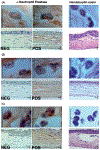Modulation of immune signaling, bacterial clearance, and corneal integrity by toll-like receptors during streptococcus pneumoniae keratitis
- PMID: 23841825
- PMCID: PMC9335516
- DOI: 10.3109/02713683.2013.804094
Modulation of immune signaling, bacterial clearance, and corneal integrity by toll-like receptors during streptococcus pneumoniae keratitis
Abstract
Purpose: Bacterial keratitis, without effective antimicrobial treatment, leads to poor patient prognosis. Even after bacterial clearance, the host inflammatory response can contribute to corneal damage. Though Streptococcus pneumoniae (pneumococcus) is a common cause of bacterial keratitis, the role of host innate immunity during pneumococcal keratitis is not well characterized. This study investigated the role of Toll-like receptors (TLRs) during pneumococcal keratitis.
Materials and methods: C57BL/6, as well as TLR2(-/-) and TLR4(-/-) mice, were infected with S. pneumoniae, and infected corneas were examined for 21 days. Quantitative real-time reverse-transcriptase polymerase chain reaction was performed using primers for genes involved in the inflammatory response and TLR signaling. Bacterial survival and leukocyte invasion were examined over a 72-h period.
Results: The corneal expression of TLR2, TLR4, and other inflammatory genes was increased at 72 h post-infection (p.i.) compared to uninfected C57BL/6 scratch controls. TLR2(-/-) mice showed a significant increase in bacterial survival at 24 h p.i. likely due to decreased neutrophil infiltration; however, after Day 5 p.i. observed clinical scores of TLR2(-/-) and C57BL/6 mice were not significantly different. In contrast, permanent corneal damage was observed for TLR4(-/-) mice over 21 days. Initially, both TLR(-/-) mouse strains exhibited lower expression levels in many immune genes, but returned to similar or elevated levels compared to C57BL/6 mice by 72 h p.i.
Conclusions: TLR2 and TLR4 are involved in the response to pneumococcal keratitis and TLR2 may aid in bacterial clearance by recruitment of neutrophils to the cornea, whereas TLR4 may be necessary to modulate the immune response to limit cellular damage.
Figures








Similar articles
-
Streptococcus pneumoniae Endopeptidase O (PepO) Elicits a Strong Innate Immune Response in Mice via TLR2 and TLR4 Signaling Pathways.Front Cell Infect Microbiol. 2016 Feb 29;6:23. doi: 10.3389/fcimb.2016.00023. eCollection 2016. Front Cell Infect Microbiol. 2016. PMID: 26973817 Free PMC article.
-
[Toll-like receptor 2 and Toll-like receptor 4 participates in mediation of acute otitis media and mortality in pneumococcal infections in mice].Zhonghua Er Bi Yan Hou Tou Jing Wai Ke Za Zhi. 2011 Dec;46(12):1009-18. Zhonghua Er Bi Yan Hou Tou Jing Wai Ke Za Zhi. 2011. PMID: 22336013 Chinese.
-
TLR4 and TLR5 on corneal macrophages regulate Pseudomonas aeruginosa keratitis by signaling through MyD88-dependent and -independent pathways.J Immunol. 2010 Oct 1;185(7):4272-83. doi: 10.4049/jimmunol.1000874. Epub 2010 Sep 8. J Immunol. 2010. PMID: 20826748 Free PMC article.
-
Corneal response to Pseudomonas aeruginosa infection.Prog Retin Eye Res. 2004 Jan;23(1):1-30. doi: 10.1016/j.preteyeres.2003.10.002. Prog Retin Eye Res. 2004. PMID: 14766315 Review.
-
Innate Immune System Activation, Inflammation and Corneal Wound Healing.Int J Mol Sci. 2022 Nov 29;23(23):14933. doi: 10.3390/ijms232314933. Int J Mol Sci. 2022. PMID: 36499260 Free PMC article. Review.
Cited by
-
The Role of Pneumococcal Virulence Factors in Ocular Infectious Diseases.Interdiscip Perspect Infect Dis. 2018 Nov 13;2018:2525173. doi: 10.1155/2018/2525173. eCollection 2018. Interdiscip Perspect Infect Dis. 2018. PMID: 30538741 Free PMC article. Review.
-
Prophylactic Vancomycin Drops Reduce the Severity of Early Bacterial Keratitis in Keratoprosthesis.PLoS One. 2015 Oct 13;10(10):e0139653. doi: 10.1371/journal.pone.0139653. eCollection 2015. PLoS One. 2015. PMID: 26460791 Free PMC article.
-
Neutrophil IL-1β processing induced by pneumolysin is mediated by the NLRP3/ASC inflammasome and caspase-1 activation and is dependent on K+ efflux.J Immunol. 2015 Feb 15;194(4):1763-75. doi: 10.4049/jimmunol.1401624. Epub 2015 Jan 21. J Immunol. 2015. PMID: 25609842 Free PMC article.
-
Unexpected Roles for Toll-Like Receptor 4 and TRIF in Intraocular Infection with Gram-Positive Bacteria.Infect Immun. 2015 Oct;83(10):3926-36. doi: 10.1128/IAI.00502-15. Epub 2015 Jul 20. Infect Immun. 2015. PMID: 26195555 Free PMC article.
-
TLR4 contributes to the host response to Klebsiella intraocular infection.Curr Eye Res. 2014 Aug;39(8):790-802. doi: 10.3109/02713683.2014.883412. Epub 2014 Mar 3. Curr Eye Res. 2014. PMID: 24588082 Free PMC article.
References
-
- Holden BA, Sweeney DF, Sankaridurg PR, Carnt N, Edwards K, Stretton S, et al. Microbial keratitis and vision loss with contact lenses. Eye Contact Lens 2003;29: S131–S134. - PubMed
-
- Bharathi MJ, Ramakrishnan R, Vasu S, Meenakshi R, Shivkumar C, Palaniappan R. Epidemiology of bacterial keratitis in a referral centre in south India. Indian J Med Microbiol 2003;21:239–245. - PubMed
-
- Ormerod LD. Causation and management of microbial keratitis in subtropical Africa. Ophthalmology 1987;94: 1662–1668. - PubMed
-
- Green M, Apel A, Stapleton F. A longitudinal study of trends in keratitis in Australia. Cornea 2008;27:33–39. - PubMed
Publication types
MeSH terms
Substances
Grants and funding
LinkOut - more resources
Full Text Sources
Other Literature Sources
Medical
